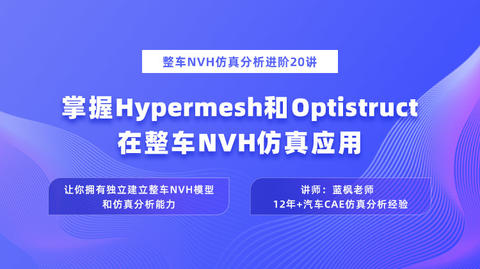Mobility、IPI 与隔振之间的关系及应用!
本文摘要(由AI生成):
本文介绍了Mobility在振动和噪声传递性能分析中的应用。首先,阐述了振动相关基本概念、质量、刚度及阻尼关系以及隔振基本概念。然后,详细解释了Mobility的概念、定义以及与刚度的关系。接着,探讨了连接组件与隔离的关系。最后,分析了IPI、Mobility及隔振之间的关系,并提出了Mobility或IPI目标值的确定方法。通过本文的介绍,读者可以更好地理解Mobility在振动和噪声传递性能分析中的作用和应用。
Mobility(迁移率)主要是对隔振元件(如悬置、衬套等)连接件局部动态刚度特性的一种考察方式,可通过对隔振安装部位进行Mobility分析,进行隔振件刚度的设定或选择。如冷却模块特定转速下的隔振垫刚度,底盘隔振件隔振性能,通过对比隔振件刚度及钣金连接点刚度,在兼顾NVH隔振及其他性能下,提升连接点刚度或降低隔振件刚度。
Mobility主要对系统中、高频的振动及噪声传递性能进行分析考察, 一般计算频率可达到500或800Hz。
一、基本理论基础
1、振动相关基本概念





二、Mobility概念
(1)Purpose of Using Rubber Mounts Motion Control Isolation;
(2)Mount stiffness greatly effects vehicle performance. In general, soft mount is good for noise, but bad for R & H;
(3)Mount Stiffness Stiffer mounts rates in radial direction will improve motion control and rough road isolation, but may increase noise levelTuning body/PT mount at each location for better Noise, Vibration, and ride performance is required after structures redesigned。
Key to NVH isolation is:
(1)Stiff attachments applied to both side soft mount;
(2)Soft rubber。
Definition
(1)Ratioof velocity to force at each frequency
(2)Given in dB, ref.
dB for Mobility
3、How are Mobility and Stiffness Related?
(1)Mobility is related to stiffness
(2)stiffness is force over displacement (k = F/X)
(3)mobility is velocity over force (M = V/F)
(4)to convert stiffness to mobility

where:
(1)k is the isolator rate (N/mm)
(2)Mk is mobility of isolator rate
(3)w is radial frequency (rad/sec = 2pf)
(4)w is needed to differentiate displacement to velocity
Example:
(1)For a stiffness of 20,000 N/mm at 150 Hz

4、Connecting Components with Isolation

三、IPI、Mobility及隔振关系

说明:
(1) Mobility 也是频域上的复数,动刚度其实是同一事物的不同表述,它们都反映物体局部动态刚度特性;
(2)Mobility越大,动刚度越小;
(3)用Mobility可以方便地推导出系统隔振的性能
2、Mobility与隔振
(1)当衬套的动刚度远小于车身和副车架接附点的动刚度时,可以有效隔振;
(2)当接附点的Mobility远大于车身和副车架接附点的Mobilit时,可以效隔振;
(3)当车身和动力总成连接点相对与悬置越刚,隔振效果越好。
3、Mobility或者 IPI 目标值的确定
(1)振动噪声控制理想的要求有20dB以上的力传递损失,降低20dB相当于力传递率是0.1;
(2)相当于能量损失99%


(3���如果车身和副车架的动刚度相同,并且其是悬置的18倍以上,则可达到20dB的力传递损失;
(4)所以NVH在对一些重要传递路径的隔振进行要求时,一般要求大于20dB;
(5)通常情况情况下,接附点动刚度值为0.2mm/s 或者 5~10倍的隔振垫刚度。







